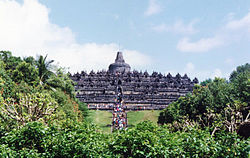
Back Sunda Vivitan Azerbaijani Sunda Wiwitan BAN सुन्दा विवितान Hindi Sunda wiwitan Croatian Sunda Wiwitan ID Sundha Wiwitan JV Sunda Wiwitan MIN Sunda Wiwitan Malay Agama Sunda Wiwitan Sundanese 古巽他族信仰 Chinese
| Sunda Wiwitan | |
|---|---|
| ᮞᮥᮔ᮪ᮓ ᮝᮤᮝᮤᮒᮔ᮪ | |
 The Cakra Flower is a symbol of Sunda Wiwitan | |
| Abbreviation | Wiwitan |
| Type | Folk religion |
| Scripture | Sanghyang Siksa Kandang Karesian |
| Governance | National Sunda Wiwitan Religious Council of the Republic Indonesia |
| Region | |
| Language |
|
| Headquarters | West Java |
| Recognition | Officially recognized by Indonesian government |
| Members |
|
| Part of a series on |
| Religion of Java |
|---|
 |
Sunda Wiwitan (from Sundanese: ᮞᮥᮔ᮪ᮓ ᮝᮤᮝᮤᮒᮔ᮪) is a folk religion and ancient beliefs adhered to by the Sundanese peoples (including Baduy & Bantenese) in Indonesia.[1]
The followers of this belief system can be found in some villages in western Java, such as Kanekes, Lebak, Banten; Ciptagelar of Kasepuhan Banten Kidul, Cisolok, Sukabumi; Kampung Naga; and Cigugur, Kuningan Regency. In Carita Parahyangan this faith is called Jatisunda. Its practitioners assert that Sunda Wiwitan has been part of their way of life since ancient times, before the arrival of Hinduism and Islam.
The sacred book of Sunda Wiwitan is called Sanghyang Siksa Kandang Karesian. It is a didactic text of religious and moral guidance, rules, and lessons. The text is identified as Kropak 630 by the National Library of Indonesia. According to the kokolot (elder) of Cikeusik village, the people of Kanekes are not adherents to Hindu or Buddhist faiths; they follow an animistic system of belief that venerates and worships the spirits of ancestors. However, over the course of time, Sunda Wiwitan has been influenced by and incorporated Hindu and, to some extent, Islamic elements.[2]